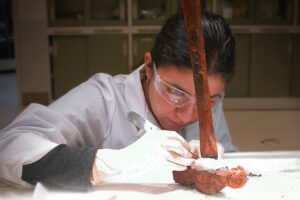Scientists will soon put the Hunley Conservation Plan to the test. The hatch the crew used to enter the submarine for the last time in 1864 will be the first part of the Hunley to be conserved. The United States Navy officially approved project scientists’ plan for conserving the Hunley, the world’s first successful combat submarine, in September of 2006.
“Implementing the conservation process on this artifact will help us be completely prepared when it comes time to treat the Hunley,” said Clemson Professor Dr. Michael Drews.
During the Hunley’s 136-year stay on the ocean floor, salts penetrated the submarine’s iron skin, leaving it vulnerable to air exposure on land. “If the Hunley was not in her protective bath, she would rapidly begin to rust and could collapse in a matter of months,” Paul Mardikian, Senior Conservator to the Hunley project said.
The submarine’s aft (rear) hatch cover will undergo the many phases of conservation before a salt-extracting treatment is applied to the Hunley. The aft hatch cover—one of two openings where the crew could enter and exit the submarine—was recently removed because it held glass components that would not survive the conservation process.
While de-concreting the artifact in the lab, scientists uncovered a lever attached to the lid. The cover appears to have a valve system installed that may have been used to release air pressure in the submarine’s crew compartment.
Once scientists realized this wasn’t just an iron lid, but also an intricately designed valve mechanism, they knew they had the rare opportunity to test their conservation plan on an object that had been exposed to the exact same saltwater contamination the Hunley experienced.
This test will give scientists an opportunity to see how well the conservation bath works in removing salt from the structural crevices—the hardest places to leach salts—that make up the valve mechanism.
“The lessons we will learn from conserving the hatch will be invaluable. On this project, we often say ‘you only have one chance to do it, so you have to do it right.’ Well, in this case, we will have two chances, but we still intend to get it right,” Hunley Commission Chairman Senator Glenn McConnell said.
Although the hatch cover is far from being as difficult a conservation challenge as the actual submarine, the lessons learned by treating it will be beneficial in preparing for a treatment of the Hunley’s hull. Very few maritime objects with such intricate and complex construction as the Hunley have been conserved. “There was no text book to follow when we began to plan for the submarine’s conservation, so we had to write our own,” Mardikian said.
Years of research, testing, and planning went into developing the Hunley Conservation Plan.
The 171-page document outlines an innovative process for conserving the Hunley and includes preliminary findings on ground-breaking research that could revolutionize the field of maritime conservation. Beyond artifact conservation, the new research may also point the way to achieve corrosion resistance for metals used in a variety of modern applications.
With suggestions from experts, the plan was revised and improved over a period of 18 months. “The magnitude of our task was enormous. We worked with experts world-wide to make sure the plan would be appropriate for an artifact as historically important as the Hunley,” Mardikian said.
Friends of the Hunley
On the evening of February 17, 1864, the H. L. Hunley became the world’s first successful combat submarine by sinking the USS Housatonic. After signaling to shore the mission had been accomplished, the submarine and her crew of eight vanished. Lost at sea for over a century, the Hunley was located in 1995 by Clive Cussler’s National Underwater and Marine Agency (NUMA). The hand-cranked vessel was raised in 2000 and delivered to the Warren Lasch Conservation Center, where an international team of scientists are at work conserving the vessel and piecing together clues to solve the mystery of her disappearance.


